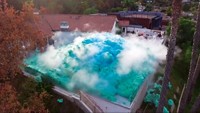Advertisement
Grab your lab coat. Let's get started
Welcome!
Welcome!
Create an account below to get 6 C&EN articles per month, receive newsletters and more - all free.
It seems this is your first time logging in online. Please enter the following information to continue.
As an ACS member you automatically get access to this site. All we need is few more details to create your reading experience.
Not you? Sign in with a different account.
Not you? Sign in with a different account.
ERROR 1
ERROR 1
ERROR 2
ERROR 2
ERROR 2
ERROR 2
ERROR 2
Password and Confirm password must match.
If you have an ACS member number, please enter it here so we can link this account to your membership. (optional)
ERROR 2
ACS values your privacy. By submitting your information, you are gaining access to C&EN and subscribing to our weekly newsletter. We use the information you provide to make your reading experience better, and we will never sell your data to third party members.
Education
Newscripts
Vampire Bat Drug for Stroke Victims, Pressure Rising for Nitrogen in Tires, Mercury Memories
by David J. Hanson
October 25, 2004
| A version of this story appeared in
Volume 82, Issue 43
Vampire bat drug for stroke victims
Vampire bat saliva is the source of a drug being tested to dissolve blood clots in stroke patients at the University of Louisville Hospital, according to an article in the Louisville, Ky., Courier-Journal. The small clinical trial is treating patients for ischemic stroke, and it is hoped that the bat-derived drug may be useful for a longer time after a stroke occurs than the current drug approved for this, tissue plasminogen activator.
The concept, however gruesome, is logical. Vampire bats drink the blood of animals by making a small cut in the skin and lapping up the blood. But the bat keeps the blood flowing because of a naturally occurring protein in its saliva that prevents the blood from clotting. If that protein could become a useful drug, it may save the lives of hundreds of thousands of stroke victims each year.
Paion, a Germany-based company whose logo resembles a flying bat, isolated the protein from the saliva of the South American vampire bat Desmodus rotundus and has developed a genetically engineered version it calls Desmoteplase. In addition to Louisville, the drug is being tested in more than 20 hospitals in the U.S. and Europe, according to the company website.
The idea that filling your car tires with pure, dry nitrogen is much better for them than using plain old air is getting increased attention. As pointed out by reader James R. Jeitler of North Idaho College and others, tire outlets around the country are offering to replace the air in your car tires with nitrogen for about $5.00 each.
There are a number of rather lofty claims being made about nitrogen in tires. These include that pressure inside nitrogen-filled tires does not rise or fall with temperature changes, that nitrogen leaks out of tires much more slowly than air because the molecules are bigger, that nitrogen is an inert gas, and that moisture and oxygen in air cause corrosion that shortens tire life by 25 to 30%.
Some credence to the idea seems to come from the use of nitrogen in tires of race cars, jet aircraft, and some heavy trucks. Although tire-pressure advantages are mentioned for these vehicles, another reason cited here is that nitrogen will not contribute to combustion in case of a fire around the tires, as the oxygen in air would.
Nitrogen generators are available for filling tires with the gas. At least one company recommends using nitrogen that is at least 98% pure in your tires to prevent rim corrosion and road failures. The nitrogen is generated using a semipermeable membrane system that allows oxygen, carbon dioxide, and water vapor to pass through, concentrating the nitrogen. This concentrated nitrogen can then be put into your tires.
Despite the claims of industry studies demonstrating that these assertions are valid, much of what is promised seems to fly in the face of logic. Reading the literature handed out by one nitrogen promoter, Jeitler said, "I was interested to find out that nitrogen no longer obeys the gas laws that we teach in general chemistry classes, much less Graham's law of effusion."
The Newscripts item describing how mercury was handled in schools years ago (C&EN, Sept. 20, page 88) inspired others to recall past practices that would be banned today. Russel E. Wellman remembers: "Up until after 1960, most chemists worked with and around a lot of mercury. It was used to measure pressure, seal traps, etcetera. In graduate school, we cleaned dirty mercury by putting it in a crock under several inches of concentrated nitric acid and slowly bubbling air though it. The crock sat in the room where we congregated to eat."
Harkening back to high school, Thomas R. Parish writes: "Every year, as the physics class was learning about pressure, a meter-long glass tube would be set in a jar of mercury. You always knew when this was taking place because all the quarters in the school cafeteria would show up shiny. I think we were all guilty of trying to make off with some of that neat stuff."
This week's column was written by David Hanson . Please send comments and suggestions to newscripts@acs.org.







Join the conversation
Contact the reporter
Submit a Letter to the Editor for publication
Engage with us on Twitter